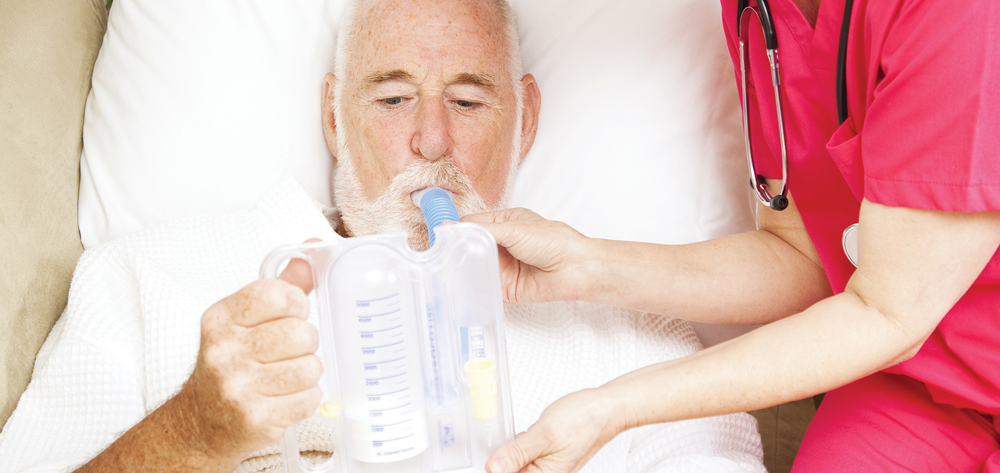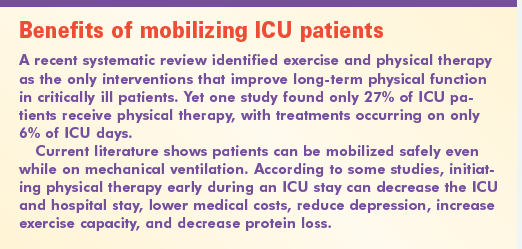More than 5 million patients are admitted to intensive care units (ICUs) every year, with survival rates approaching 80%. But when they leave the ICU, many patients experience muscle weakness from bed rest and immobility. Some also suffer immobility complications, such as pneumonia and deep vein thrombosis. Early mobility is essential to preventing complications and enhancing quality of life after discharge.
Unfortunately, evidence-based protocols for early mobility are still being developed and aren’t easy to find. In 2013, a literature review was followed by a meeting of ICU experts to seek a consensus on safe mobilization of mechanically ventilated ICU patients. It marked the first time a consensus was reached on safety parameters for mobilizing ICU patients. The authors summarized four safety categories to consider when determining if a patient should be mobilized—respiratory, cardiovascular, neurologic, and other (presence of central and arterial lines and surgical or medical conditions). They determined that endotracheal intubation isn’t a valid reason for keeping a patient on bed rest; also, early mobilization (getting in and out of bed) is safe for patients with a fraction of inspired oxygen below 0.6, oxygen saturation above 90%, and respiratory rate less than 30 breaths/minute. However, consensus wasn’t reached on safe mobilization of patients receiving vasoactive agents.
Of course, mobilizing ICU patients isn’t easy, and something can always go wrong. But mobilization is crucial for avoiding discharge of patients with severe weakness, self-care limitations, and poor quality of life.
So why aren’t we mobilizing patients sooner? In some cases, nurse staffing concerns play a role. Many nurses worry that mobilizing patients will increase their workload. Compliance with patient mobilization, repositioning, transferring to a bedside chair, or walking may hinge on staffing, patient acuity, resources, and patient assignments. Also, many ICUs lack protocols, activity orders, and guidelines for patient activity.
Changing the culture
The five strategies described below can help foster an ICU culture that promotes early mobility.
1. Lay the groundwork.
Depending on the facility, work on guideline and protocol development, an interdisciplinary project team, electronic health record documentation, statistical reports, and pilot programs may be prerequisites for initiating an early-mobility program. Also, mobilization equipment must be pur- chased.
2. Find mobility champions.
Staff members interested in promoting patient mobility can be identified as mobility champions, who can teach staff how to integrate the mobility protocol into daily nursing care. Goals for mobility champions include:
- modeling how to implement the protocol
- reinforcing the importance of patient mobilization
- assisting other staff to ensure maximal adherence to a
mobility protocol.
The charge nurse or shift manager can serve as an additional asset by gathering equipment and personnel for patient mobilization and offering the primary nurse additional help for protocol activities.
3. Provide education.
Committed education time for multidisciplinary staff, patients, and families can help everyone understand mobilization risks and benefits. Educate unit staff (including nurses, nursing assistants, nurse practitioners, residents, attending physicians, physical therapists, and respiratory therapists) about the deconditioning effects of an ICU stay and the benefits of patient mobilization. (See Benefits of mobilizing ICU patients.) Education can be provided during staff meetings and physician grand rounds, as well as through newsletters, journal clubs, and one-to-one meetings.
Physical and occupational therapists are important team members who can educate staff on how to:
- assess the patient’s mobility level and readiness to progress through the mobility protocol, guidelines, or levels
- provide passive range-of-motion (ROM) exercises
- identify mobilization contraindications.
Also, patient education materials need to be developed and given to each patient or family member on admission to the ICU or acute-care clinic before scheduled surgery. Family members need to understand the importance of patient mobility in the ICU environment.
4. Use staff appropriately.
To increase night staff compliance with patient mobilization, ROM exercises can be accomplished on night shift when baths are given, so staff can incorporate exercises into their nightly nursing routines. During the day, nursing or physical therapy staff can perform mobility activities with the patient. In addition, staff should be educated on how to incorporate ROM exercises during usual nursing care, as well as on ways to enlist family help with those exercises.
5. Offer tools for success.
A mobility whiteboard can be developed to hang on the wall of each patient room. Staff can use this board to identify the patient’s mobility progress throughout the week and document the number and types of mobility activities accomplished during a shift.
Other tools to promote success include theme celebrations (such as “Let’s Move it”) and marking the hospital floor or baseboard floor every 10ꞌ so the patient, family, and staff can quantify the patient’s mobility progress. To encourage implementation, leaders can develop incentives, such as paper “mobility bucks” to be handed out to staff in appreciation for following the protocol. Mobility bucks could be used as money in the hospital cafeteria.
Sustaining the effort
With a major project such as early mobilization, sustainment is an important component of culture change. The TeamSTEPPS® program, which consists of six steps needed to sustain a mobility program, can help guide an early-mobility sustainment program. The steps include:
1. providing practice opportunities
2. ensuring that leaders emphasize new skills
3. providing regular feedback
4. celebrating wins
5. measuring success
6. updating current plans.
Audits provide a way to gather statistics on mobility protocol compliance. Statistics can be compiled and posted on a unit’s quality indicator or communication board and communicated via email or staff meetings. When mobility protocol compliance increases, the unit can celebrate its success.
The danger of immobility/Mobility protocol
References
Adler J, Malone D. Early mobilization in the intensive care unit: a systematic review. Cardiopulm Phys Ther J. 2012;23(1):5-13.
Agency for Healthcare Research and Quality. TeamSTEPPS®: National implementation. November 2013. teamstepps.ahrq.gov/aboutnationalip.htm
Engel HJ, Needham DM, Morris PE, Gropper MA. ICU early mobilization: from recommendation to implementation at three medical centers. Crit Care Med. 2013;41(9 Suppl 1):S69-80.
Hildreth AN, Enniss T, Martin RS, et al. Surgical intensive care unit mobility is increased after institution of a computerized mobility order set and intensive care unit mobility protocol: a prospective cohort analysis. Am Surg. 2010;76(8):818-22.
Hodgson CL, Stiller K, Needham DM, et al. Expert consensus and recommendations on safety criteria for active mobilization of mechanically ventilated critically ill adults. Crit Care. 2014;18(6):658.
Kayambu G, Boots R, Paratz J. Physical therapy for the critically ill in the ICU: a systematic review and meta-analysis. Crit Care Med. 2013;41(6):1543-54.
Lipshutz AK, Gropper MA. Acquired neuromuscular weakness and early mobilization in the intensive care unit. Anesthesiology. 2013;118(1):202-15.
Society of Critical Care Medicine. Critical care statistics. sccm.org/Communications/Pages/CriticalCareStats.aspx
Zomorodi M, Topley D, McAnaw M. Developing a mobility protocol for early mobilization of patients in a surgical/trauma ICU. Crit Care Res Pract. 2012;2012:964547.
Darla Topley is a thoracic/cardiac/vascular ICU clinical nurse specialist at the University of Virginia Health System in Charlottesville.



















